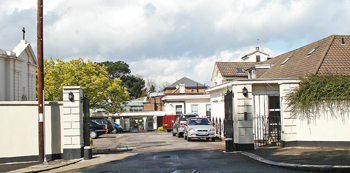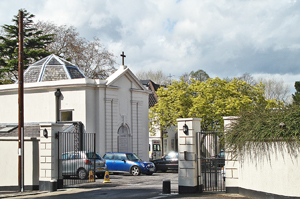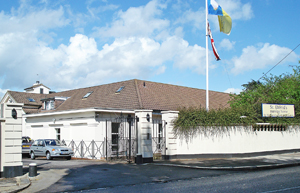Long-term care
In 1918 a suitable property with 3 acres of well-wooded grounds - Kent House in Castlebar Hill - was purchased for £7,500.
The 2-storey building, built in 1845, was entered through a central grand four-column portico. Conditions inside were primitive but, nevertheless, the ground floor rooms were converted into wards, as were the stables (where, above each bed, was an iron ring to which horses had been tethered). The hay lofts were made into living quarters for the orderlies. A small furnace at the end of the stable block provided hot water. The coach house was divided into a laundry and a mortuary.
St David's Home was officially opened 17th October 1918 by Cardinal Bourne to provide long-term care for discharged servicemen suffering from paralysis or chronic heart disease. The four wards were named English Martyrs, St Richard, St Helen and Our Lady of Lourdes. The first patients had already arrived in August (on Assumption Day), transferred from military hospitals by the Ministry of Pensions, who provided a capitation grant for their maintenance. Of the 40 beds, 21 were already occupied.
By April 1919 30 had been admitted, most of whom were serious cases.
At first, nursing care had been provided by the Franciscan Missionaries of Mary, but at the end of the war they wished to return to their foreign missions. They were replaced in September 1920 by six Sisters of Charity, including Lady Anne's sister, Lady Etheldreda, who had joined the order as Ma Soeur Howard.
Although run by a Catholic order, the Home accepted all denominations; Catholics rarely exceeded one-third of inmates. At first a small room on the first floor was used as a chapel until enough funds had been raised to build one.
The chapel opened at Christmas 1920. It was named St David's Chapel and dedicated to the memory of Lt. David Kerr, killed in the first year of the war at the age of 21 years.
The Home soon required more accommodation and the gatehouse by the driveway was converted into a ward. As the funds for this had been mainly collected by the Children of Mary, it was named St Mary's Ward.
On 23rd November 1925 Cardinal Bourne opened a new large ward - St Joseph's Ward - which had been designed on contemporary hospital lines.
In 1926 building work began on the Memorial Cloister, where bedridden patients could be wheeled out to enjoy the fresh air, and on the Courtyard Garden.
In 1927 a new entrance to the site was completed, as was a small ward - St John's Ward - on the west side of the Courtyard Garden.
Although a fourth new ward was needed, there were no funds for this purpose. However, half an hour before the Committee of Management met to announce this, a stranger handed Mrs Passmore an envelope before walking away. The envelope contained £1,000. Despite not being sufficient to pay for a new ward, the money enabled the Committee to raise a loan from the Alliance Assurance Company. The ward opened in 1929 and contained private rooms. It was named St Thomas' Ward, after Sir Thomas More.
Each ward was in charge of a Daughter of Charity, who was assisted by male orderlies. (Later, lay nurses, and male and female care assistants joined the staff.)
In 1948, when the Home had 60 beds, it was disclaimed from the NHS and continued to be run on charitable grounds.
In 1950 a recreation room, where residents could go during the day, was built. Named St Peter's Hall, it had been funded by Mr H.G. Brockman, a local resident, who had begun a fund-raising campaign in 1945. By 1948 some £10,000 had been raised for the Home. However, because of post-war building restrictions, the Hall was not completed until October 1950, a month before Mr Brockman's unexpected death.
In 1968 the Home received another anonymous gift - of £100,000 - with the instruction that £20,000 was to be spent on essential repairs and the rest invested.
One of the improvements was the erection of a covered way, so that patients and staff were protected from the elements when going from one part of the Home to another. The glass-walled corridor was opened on 24th July 1970 by Paul Dean, M.P., Parliamentary Undersecretary in the Department of Health and Social Security.
In July 1970 the Army Benevolent Fund (A.B.F.) presented the Home with a minibus, so that those residents who were not bedridden could enjoy day trips out. Three years later the A.B.F. enabled the minibus to be traded in for a larger coach designed to take wheelchairs.
Between 1980 and 1986 the A.B.F. paid for the wards to be modernised and the orderlies' rooms to be refurbished. Fire doors and alarm systems were fitted to meet with regulations. In 1981 Cardinal Hume unveiled a plaque in acknowledgement of the financial help provided to the Home by the A.B.F.
In 1982 an ambulance with a hydraulic lift was acquired, which enabled wheelchairs to be loaded into the vehicle more easily. This, too, was a gift from the A.B.F.
In 1986 work began to convert the Memorial Cloister, which overlooked the Courtyard Garden, into a dining hall (usually all meals were served on the wards from trolleys). The project, including furnishings and fittings, was entirely funded by Ronald Gerard, O.B.E., at a cost of £56,000. Mr Gerard himself opened the Hall on 19th November 1987.
By the end of the 1990s the Sisters of Charity had gradually handed over the management of the Home to a Board of Trustees. The convent closed in 2002 and the remaining nuns moved to other convents.
In July 2003 ex-servicewomen were admitted to the Home for the first time.
In April 2006 the vacant convent premises were converted into the John Poland Rehabilitation Unit. Named after a former chairman of the Board of Trustees, it contains seven small apartments and provides intermediate care for ex-service personnel. A well-equipped physiotherapy room on the ground floor is available for use by all residents.
In 2008 the Lord Mark Wing opened. It contains 18 beds, bringing the bed complement of the Home to 68.
A Day Care Support service was established in 2009 to provide assistance for those who wished to remain in their own homes, but nonetheless needed a little support.
Present status (February 2015)
The Home is still operational and consists of three units.
The main unit - St Thomas, St Joseph and the Ronald Gerard Hall - contains 41 beds for physically frail residents, usually aged over 65 years. Patients requiring palliative care are also admitted from the local hospice.
The second unit - the John Poland Rehabilitation Unit - provides rehabilitation and therapies to enable disabled people, aged from 18 years onwards, to regain independence.
The third unit consists of the Lord Mark and General Leask Wing, named after two former Trustees, Lord Mark Fitzalan Howard and Major General Anthony Leask. It has 18 beds for physically disabled residents who, despite being wheelchair-bound, like to enjoy some independence. The Wing has its own kitchen, dining room and lounge.

The entrance to the Home.

The chapel is to the left of the entrance driveway. It was dedicated to the memory of Lt. David Kerr, the son of Major General Lord Ralph and Lady Anne Kerr.

The low-level building on the right-hand side of the entrance, with signage and flags.
(Author unstated) 1918 Care of the wounded. British journal of Nursing, 25th May, 365.
Kerr C 1928 Chapter IX St David's Home. Memoir of a Sister of Charity (Lady Etheldreda Fitzalan Howard). New York, Benziger Brothers.
Watson L 1988 The Story of St David's: The Ealing Home for Disabled Ex-Servicemen, 2nd edn. Self-published.
http://archive.thetablet.co.uk (1)
http://archive.thetablet.co.uk (2)
http://archive.thetablet.co.uk (3)
http://collage.cityoflondon.gov.uk
http://prints.paimages.co.uk
www.british-history.ac.uk
www.careplace.org.uk
www.independent.co.uk
www.ribapix.com
www.stdavidshome.org
www.tunerider.com (1)
www.tunerider.com (2)
Return to home page